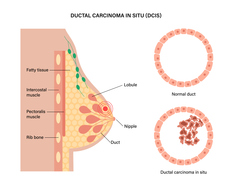Methods to be Used in Conjunction with Biomarker Ratio Imaging Microscopy
TECHNOLOGY NUMBER: 2019-182
Tags:

OVERVIEW
Improved prognostic accuracy of DCIS by augmented biomarker ratio imaging microscopy (BRIM)- Incorporation of biomarker CD44 measurement in extracellular matrix with BRIM scores
- Statistical optimization analysis (SOA) to augment prognostic powers of BRIM
BACKGROUND
Ductal carcinoma in situ (DCIS) is a pre-cancerous breast disease that commonly affects women and which may recur after treatment or even progress to invasive ductal carcinoma (IDC). Still, increasing evidence suggests that many women with DCIS may be best served with active surveillance rather than aggressive treatment, depending upon the aggressiveness of the affected cells. Ongoing research has focused on the best means by which to classify the cases which deserve treatment, and researchers previously described a protocol for doing such through use of biomarker ratio imaging microscopy (BRIM) on tissue biopsies. The BRIM approach involves use of a fluorescent biomarkers which correlate to opposing sides of one attribute in order to give a high contrast image of a specific cellular characteristic. Any one of several biomarker pairs can be used to assess multiple breast cancer properties with the same instrumentation. Further advancements in data analysis and research into BRIM could allow for even greater statistical differentiation power, more confident assignments in tissue diagnosis, and the ability to use BRIM to improve genomic testing.
INNOVATION
Researchers at the University of Michigan have invented a method to improve the success rates for prognostic predictions of women with ductal carcinoma in situ (DCIS) of the breast through incorporation of a biomarker measurement to the existing biomarker ratio imaging microscopy (BRIM) technology. The inventors discovered that a non-kinase transmembrane proteoglycan named CD44 may be present in the extracellular matrix of DCIS samples in a distribution that can be incorporated with BRIM measurements to improve the ability to predict prognosis in this setting. While the biological process causing the presence of CD44 in these areas is unknown, the researchers postulate that the leakiness of tumor blood vessels and poor drainage causes increased pressure that leads slow-diffusing proteins to become broadly distributed. A composite BRIM score calculated from this statistical analysis of CD44 concentrations in the duct and extracellular matrix increases sensitivity and specificity of the existing BRIM test through reducing noise in the data. Statistical optimization analysis (SOA) is employed to filter data in order to minimize natural variability in gene expression and to limit the associated errors in calculations. The improved prognostic predictability created by augmentation of the BRIM assessment provides a more powerful means by which to separate out patients with high- versus low-risk DCIS.